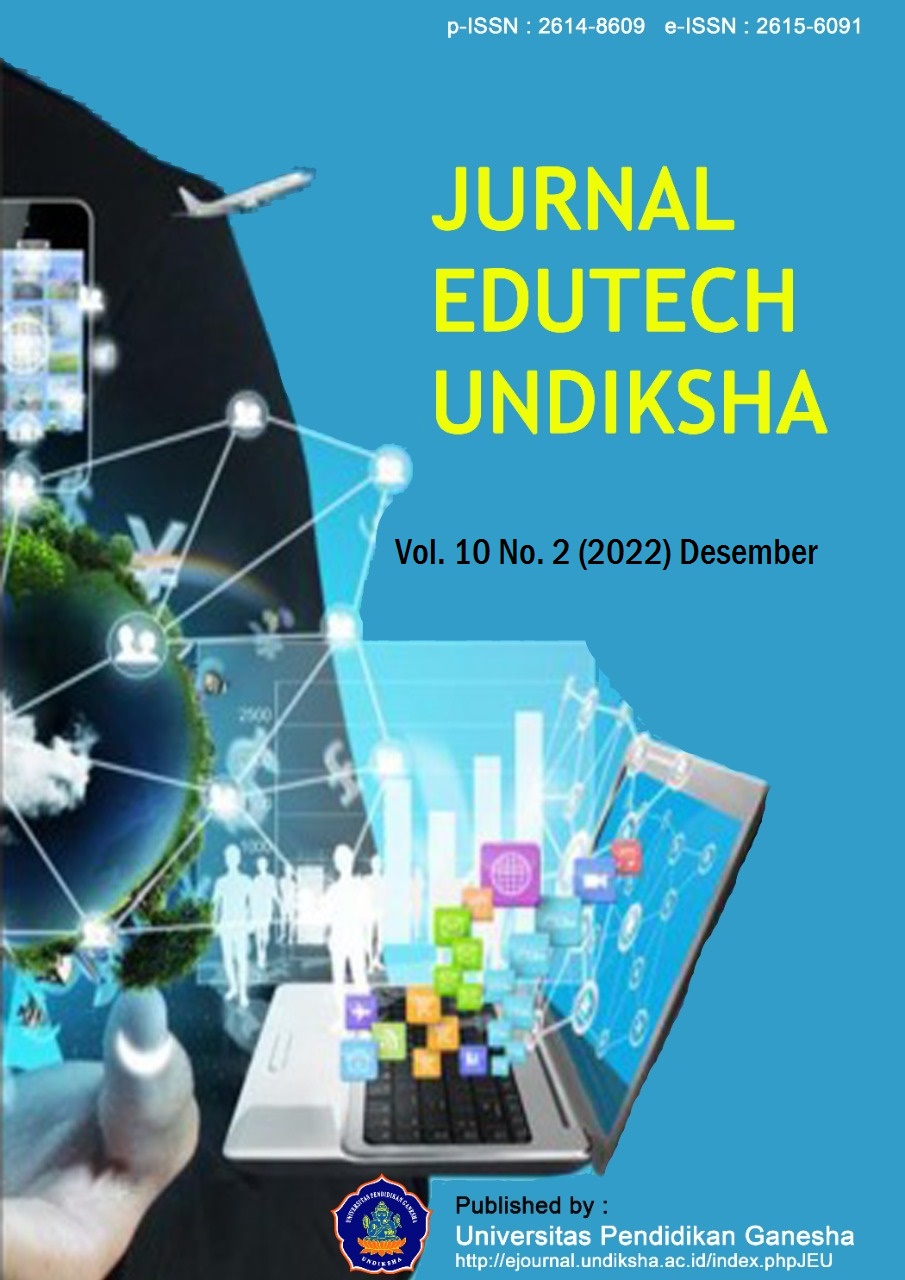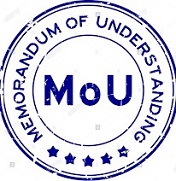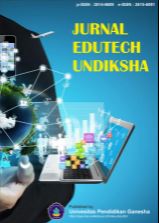Virtual Reality as a Media for Learn Animal Diversity for Students
DOI:
https://doi.org/10.23887/jeu.v10i2.50557Keywords:
Virtual Reality, Instructional Media, Animal DiversityAbstract
In the educational process, students face various problems, one of which is the difficulty in understanding the material due to its complexity of the material. New technology-based media are being introduced that help students in the learning process, such as virtual reality (VR). This research aims to produce a product in the form of virtual reality development media as a learning medium for animal diversity. This type of research is developed using a 4D model design. The data collection method uses non-test with research instruments, namely expert validation questionnaires and user validation questionnaires. As well as data analysis techniques using descriptive analysis to describe the results of questionnaires distributed to experts, practitioners, and students as research subjects consisting of media experts, material experts, practitioners, and students. The results of the product feasibility tests carried out on media experts, material experts, and students get many positive responses. So it can be concluded that the virtual reality media of animal diversity is suitable for learning. This media makes it easy for students to understand the variety of animals and provides an attraction for students so that an increased desire to learn arises.
References
Al-Gindy, A., Felix, C., Ahmed, A., Matoug, A., & Alkhidir, M. (2020). Virtual reality: Development of an integrated learning environment for education. International Journal of Information and Education Technology, 10(3), 171–175. https://doi.org/10.18178/ijiet.2020.10.3.1358. DOI: https://doi.org/10.18178/ijiet.2020.10.3.1358
Amelia, R., Salamah, U., Abrar, M., Desnita, D., & Usmeldi, U. (2021). Improving Student Learning Outcomes Through Physics Learning Media Using Macromedia Flash. Journal of Education Technology, 5(3), 491–500. https://doi.org/10.23887/jet.v5i3.36203. DOI: https://doi.org/10.23887/jet.v5i3.36203
Astriyani, A., & Zahra, A. I. (2021). Inovasi Media Pembelajaran Materi Aritmatika Sosial Berbasis Mobile Android Untuk Mendukung Kemampuan Spasial Visual Siswa Smp Kelas VIII. EMTEKA: Jurnal Pendidikan Matematika, 2(1), 25–36. https://doi.org/10.24127/emteka.v2i1.735. DOI: https://doi.org/10.24127/emteka.v2i1.735
Batsila, A. (2020). Inter-Learner Communication and Collaborative Learning as Quality Criteria of Distance Vocational Education and Training. European Journal of Open, Distance and E-Learning, 22(2), 98–112. https://doi.org/10.2478/eurodl-2019-0013. DOI: https://doi.org/10.2478/eurodl-2019-0013
Budi, A. S., Sumardani, D., Muliyati, D., Bakri, F., Chiu, P.-S., Mutoharoh, M., & Siahaan, M. (2021). Virtual Reality Technology in Physics Learning: Possibility, Trend, and Tools. Jurnal Penelitian & Pengembangan Pendidikan Fisika, 7(1), 23–34. https://doi.org/10.21009/1.07103. DOI: https://doi.org/10.21009/1.07103
Budiarto, M. K., Rejekiningsih, T., & Sudiyanto, S. (2021). Students’ opinions on the need for interactive multimedia development for entrepreneurship learning. International Journal of Evaluation and Research in Education (IJERE), 10(4), 1290. https://doi.org/10.11591/ijere.v10i4.21411. DOI: https://doi.org/10.11591/ijere.v10i4.21411
Camilleri, M. A., & Camilleri, A. C. (2017). Digital Learning Resources and Ubiquitous Technologies in Education. Technology, Knowledge and Learning, 22(1), 65–82. https://doi.org/10.1007/s10758-016-9287-7. DOI: https://doi.org/10.1007/s10758-016-9287-7
Çoban, M., & Göksu, İ. (2022). Using virtual reality learning environments to motivate and socialize undergraduates in distance learning. Participatory Educational Research, 9(2). https://doi.org/10.17275/per.22.36.9.2. DOI: https://doi.org/10.17275/per.22.36.9.2
Cvetković, B. N., & Stanojević, D. (2017). Educational needs of teacher for introduction and application of innovative models in educational work to improve teaching. International Journal of Cognitive Research in Science, Engineering and Education, 5(1), 49–56. https://doi.org/10.5937/IJCRSEE1701049N. DOI: https://doi.org/10.5937/IJCRSEE1701049N
Doğru, O. (2020). An investigation of pre-service visual arts teachers’ perceptions of computer self-efficacy and attitudes towards web-based instruction. International Journal of Research in Education and Science, 6(4), 629–637. https://doi.org/10.46328/ijres.v6i4.1454. DOI: https://doi.org/10.46328/ijres.v6i4.1454
Dwi Apriliani, N. M. P., Wibawa, I. M. C., & Rati, N. W. (2019). Pengaruh Model Pembelajaran Inkuiri Terbimbing Terhadap Hasil Belajar IPA. Jurnal Penelitian Dan Pengembangan Pendidikan, 3(2), 122. https://doi.org/10.23887/jppp.v3i2.17390. DOI: https://doi.org/10.23887/jppp.v3i2.17390
Elmqaddem, N. (2019). Augmented Reality and Virtual Reality in education. Myth or reality? International Journal of Emerging Technologies in Learning. https://doi.org/10.3991/ijet.v14i03.9289. DOI: https://doi.org/10.3991/ijet.v14i03.9289
Fitria, A. D., Mustami, M. K., & Taufiq, A. U. (2017). Pengembangan Media Gambar Berbasis Potensi Lokal Pada Pembelajaran Materi Keanekaragaman Development of Picture Media Based on Local Potency for Learning Materials Biodiversity in. AULADUNA: Jurnal Pendidikan Dasar Islam, 4(2), 14–28. http://repositori.uin-alauddin.ac.id/8473/.
Gunawan, I. (2013). Metode penelitian kualitatif: Teori dan praktik. Bumi Aksara.
Har, E., Khairi, A., & Roza, W. (2019). Teachers’ skills and ICT facilities for science learning at senior high school in Padang city. Australian Educational Computing, 34(1). http://journal.acce.edu.au/index.php/AEC/article/view/177.
Huang, C. L., Luo, Y. F., Yang, S. C., Lu, C. M., & Chen, A. S. (2020). Influence of Students’ Learning Style, Sense of Presence, and Cognitive Load on Learning Outcomes in an Immersive Virtual Reality Learning Environment. Journal of Educational Computing Research, 58(3), 596–615. https://doi.org/10.1177/0735633119867422. DOI: https://doi.org/10.1177/0735633119867422
Ilic, P. (2021). The Challenge of Information and Communications Technology in Education. SHS Web of Conferences, 102, 01009. https://doi.org/10.1051/shsconf/202110201009. DOI: https://doi.org/10.1051/shsconf/202110201009
Imanuel, S. A. (2015). Kesulitan Belajar IPA Peserta Didik Sekolah Dasar. Vox Edukasi, 6(2), 143–155. https://doi.org/https://doi.org/10.31932/ve.v6i2.106.
Jang, J., Ko, Y., Shin, W. S., & Han, I. (2021). Augmented Reality and Virtual Reality for Learning: An Examination Using an Extended Technology Acceptance Model. IEEE Access, 9, 6798–6809. https://doi.org/10.1109/ACCESS.2020.3048708. DOI: https://doi.org/10.1109/ACCESS.2020.3048708
Kamińska, D., Sapiński, T., Wiak, S., Tikk, T., Haamer, R. E., Avots, E., Helmi, A., Ozcinar, C., & Anbarjafari, G. (2019). Virtual reality and its applications in education: Survey. Information (Switzerland), 10(10). https://doi.org/10.3390/info10100318. DOI: https://doi.org/10.3390/info10100318
Kareem, A. A. (2018). The Use of Multimedia in Teaching Biology and Its Impact on Students ’ Learning Outcomes. The Eurasia Proceedings of Educational & Social Sciences, 9(1), 157–165. https://dergipark.org.tr/en/download/article-file/531778.
Kusuma, G. T. A., Wirawan, I. M. A., & Arthana, I. K. R. (2018). Virtual reality for learning fish types in kindergarten. International Journal of Interactive Mobile Technologies, 12(8), 41–51. https://doi.org/10.3991/ijim.v12i8.9246. DOI: https://doi.org/10.3991/ijim.v12i8.9246
Kuswanto, J., Yunarti, Y., Lastri, N., Dapiokta, J., & Adesti, A. (2021). Development Learning Media Based Android for English Subjects. Journal of Physics: Conference Series, 1779(1). https://doi.org/10.1088/1742-6596/1779/1/012020. DOI: https://doi.org/10.1088/1742-6596/1779/1/012020
Machmud, M. T., Widiyan, A. P., & Ramadhani, N. R. (2021). The development and policies of ICT supporting educational technology in Singapore, Thailand, Indonesia, and Myanmar. International Journal of Evaluation and Research in Education (IJERE), 10(1), 78–85. https://doi.org/10.11591/ijere.v10i1.20786. DOI: https://doi.org/10.11591/ijere.v10i1.20786
Makarova, E. A., & Makarova, E. L. (2018). Blending pedagogy and digital technology to transform educational environment. International Journal of Cognitive Research in Science, Engineering and Education, 6(2), 57–65. https://doi.org/10.5937/ijcrsee1802057M. DOI: https://doi.org/10.5937/ijcrsee1802057M
Malik, R. S. (2018). Educational challenges in 21st century and sustainable development. Journal of Sustainable Development Education and Research, 2(1), 9–20. https://doi.org/10.17509/jsder.v2i1.12266. DOI: https://doi.org/10.17509/jsder.v2i1.12266
Margunayasa, I. G., Dantes, N., Marhaeni, A. A. I. N., & Suastra, I. W. (2019). The Effect of Guided Inquiry Learning and Cognitive Style on Science Learning Achievement. International Journal of Instruction, 12(1), 737–750. https://doi.org/10.29333/iji.2019.12147a. DOI: https://doi.org/10.29333/iji.2019.12147a
Marini, A., Maksum, A., Satibi, O., Edwita, Yarmi, G., & Muda, I. (2019). Model of student character based on character building in teaching learning process. Universal Journal of Educational Research, 7(10), 2089–2097. https://doi.org/10.13189/ujer.2019.071006. DOI: https://doi.org/10.13189/ujer.2019.071006
Mariscal, G., Jiménez, E., Vivas-Urias, M. D., Redondo-Duarte, S., & Moreno-Pérez, S. (2020). Virtual reality simulation-based learning. Education in the Knowledge Society, 21. https://doi.org/10.14201/eks.20809. DOI: https://doi.org/10.14201/eks.23004
Marta, L. C. (2019). The Integration of digital devices into learning spaces according to the needs of primary and secondary teachers. TEM Journal, 8(4), 1351–1358. https://doi.org/10.18421/TEM84-36.
Martín-Gutiérrez, J., Mora, C. E., Añorbe-Díaz, B., & González-Marrero, A. (2017). Virtual Technologies Trends in Education. EURASIA Journal of Mathematics, Science and Technology Education, 13(2), 469–486. https://doi.org/10.12973/eurasia.2017.00626a. DOI: https://doi.org/10.12973/eurasia.2017.00626a
Membiela, P., Vidal, M., Fragueiro, S., Lorenzo, M., García-Rodeja, I., Aznar, V., Bugallo, A., & González, A. (2022). Motivation for science learning as an antecedent of emotions and engagement in preservice elementary teachers. Science Education, 106(1), 119–141. https://doi.org/10.1002/sce.21686. DOI: https://doi.org/10.1002/sce.21686
Molina-Carmona, R., Pertegal-Felices, M. L., Jimeno-Morenilla, A., & Mora-Mora, H. (2018). Virtual Reality learning activities for multimedia students to enhance spatial ability. Sustainability (Switzerland), 10(4). https://doi.org/10.3390/su10041074. DOI: https://doi.org/10.3390/su10041074
Mulders, M., Buchner, J., & Kerres, M. (2020). A Framework for the Use of Immersive Virtual Reality in Learning Environments. International Journal of Emerging Technologies in Learning, 15(24), 208–224. https://doi.org/10.3991/ijet.v15i24.16615. DOI: https://doi.org/10.3991/ijet.v15i24.16615
Muñoz-Saavedra, L., Miró-Amarante, L., & Domínguez-Morales, M. (2020). Augmented and virtual reality evolution and future tendency. Applied Sciences (Switzerland), 10(1). https://doi.org/10.3390/app10010322. DOI: https://doi.org/10.3390/app10010322
Nur Jannah, I. (2020). Efektivitas Penggunaan Multimedia dalam Pembelajaran IPA di SD. Jurnal Ilmiah Sekolah Dasar, 4(1), 54. https://doi.org/10.23887/jisd.v4i1.24135. DOI: https://doi.org/10.23887/jisd.v4i1.24135
Ören, F. Ş. (2019). The Innovative Group Learning Design : Instructional Group Activities. International Online Journal of Education and Teaching (IOJET), 6(2), 356–377. https://eric.ed.gov/?id=EJ1248490.
Osadebe, P. U., & Osadebe, J. F. (2020). Undergraduate business education students’ perception on information and communication technology use in teaching and learning. International Journal of Evaluation and Research in Education, 9(2), 359–363. https://doi.org/10.11591/ijere.v9i2.20326. DOI: https://doi.org/10.11591/ijere.v9i2.20326
Paszkiewicz, A., Salach, M., Dymora, P., Bolanowski, M., Budzik, G., & Kubiak, P. (2021). Methodology of implementing virtual reality in education for industry 4.0. Sustainability (Switzerland), 13(9). https://doi.org/10.3390/su13095049. DOI: https://doi.org/10.3390/su13095049
Pertiwi, U. D., Atanti, R. D., & Ismawati, R. (2018). Pentingnya Literasi Sains Pada Pembelajaran IPA SMP Abad 21. Indonesian Journal of Natural Science Education (IJNSE), 1(1), 24–29. https://doi.org/10.31002/nse.v1i1.173. DOI: https://doi.org/10.31002/nse.v1i1.173
Pinto da Mota Matos, A., Isabel Festas, M., & Maria Seixas, A. (2016). Digital media and the challenges for media education. Applied Technologies and Innovations, 12(2). https://doi.org/10.15208/ati.2016.04. DOI: https://doi.org/10.15208/ati.2016.04
Prihantoro, C. R. (2018). Pengaruh E-readiness, E-learning dan E-book pada Implementasi Kurikulum Program Studi D3 Teknologi Mesin terhadap Prestasi Lulusan Program Diploma. JTP - Jurnal Teknologi Pendidikan, 20(2), 105–119. https://doi.org/10.21009/jtp.v20i2.8619. DOI: https://doi.org/10.21009/jtp.v20i2.8619
Puspitasari, A. D. (2019). Penerapan Media Pembelajaran Fisika Menggunakan Modul Cetak dan Modul Elektronik pada Siswa SMA. Jurnal Pendidikan Fisika, 7(1), 17–25. https://doi.org/https://doi.org/10.24252/jpf.v7i1.7155.
Qodr, T. S., Efendi, A., & Musadad, A. A. (2021). Opportunities for Using Smartphones in the Digital Era to Facilitate Students in Learning Sociology in High Schools. Journal of Education Technology, 5(2), 263–271. https://doi.org/10.23887/jet.v5i2.34806. DOI: https://doi.org/10.23887/jet.v5i2.34806
Raja, M., & Priya, G. G. L. (2021). An Analysis of Virtual Reality Usage through a Descriptive Research Analysis on School Students’ Experiences: A Study from India. International Journal of Early Childhood Special Education, 13(2), 990–1005. https://doi.org/10.9756/INT-JECSE/V13I2.211142. DOI: https://doi.org/10.9756/INT-JECSE/V13I2.211142
Raji, B. (2019). Significance and challenges of computer assisted education programs in the UAE: A case study of higher learning and vocational education. Education and Information Technologies, 24(1), 153–164. https://doi.org/10.1007/s10639-018-9767-6. DOI: https://doi.org/10.1007/s10639-018-9767-6
Ramadhani, R., & Muhtadi, A. (2018). Development of Interactive Multimedia in Learning Islamic Education. International Journal of Multicultural and Multireligious Understanding, 5(6), 9–15. https://doi.org/10.18415/ijmmu.v5i6.488. DOI: https://doi.org/10.18415/ijmmu.v5i6.488
Rashid, A. H. A., Shukor, N. A., Tasir, Z., & Na, K. S. (2021). Teachers’ perceptions and readiness toward the implementation of virtual learning environment. International Journal of Evaluation and Research in Education, 10(1), 209–214. https://doi.org/10.11591/ijere.v10i1.21014. DOI: https://doi.org/10.11591/ijere.v10i1.21014
Rejekiningsih, T., Budiarto, M. K., & Sudiyanto, S. (2021). Pengembangan Multimedia Interaktif Berbasis Potensi Lokal Untuk Pembelajaran Prakarya Dan Kewirausahaan Di SMA. Kwangsan: Jurnal Teknologi Pendidikan, 9(2), 167. https://doi.org/10.31800/jtp.kw.v9n2.p167--185. DOI: https://doi.org/10.31800/jtp.kw.v9n2.p167--185
Renganayagalu, S. kumar, Mallam, S. C., & Nazir, S. (2021). Effectiveness of VR Head Mounted Displays in Professional Training: A Systematic Review. Technology, Knowledge and Learning, 26(4), 999–1041. https://doi.org/10.1007/s10758-020-09489-9. DOI: https://doi.org/10.1007/s10758-020-09489-9
Ristanto, R. H., Miarsyah, M., Luthfi, I. A., Kristiani, E., & Hasanah, R. (2020). Invertebrate-interactive dichotomous key media: Enhance students learning motivation in lower secondary school. International Journal of Information and Education Technology, 10(9), 669–673. https://doi.org/10.18178/ijiet.2020.10.9.1441. DOI: https://doi.org/10.18178/ijiet.2020.10.9.1441
Riyanto, Amin, M., Suwono, H., & Lestari, U. (2020). The new face of digital books in genetic learning: A preliminary development study for students’ critical thinking. International Journal of Emerging Technologies in Learning, 15(10), 175–190. https://doi.org/10.3991/ijet.v15i10.14321. DOI: https://doi.org/10.3991/ijet.v15i10.14321
Roemintoyo, R., & Budiarto, M. K. (2021). Flipbook as Innovation of Digital Learning Media: Preparing Education for Facing and Facilitating 21st Century Learning. Journal of Education Technology, 5(1), 8. https://doi.org/10.23887/jet.v5i1.32362. DOI: https://doi.org/10.23887/jet.v5i1.32362
Sattar, M. U., Palaniappan, S., Lokman, A., Hassan, A., Shah, N., & Riaz, Z. (2019). Effects of virtual reality training on medical students’ learning motivation and competency. Pakistan Journal of Medical Sciences, 35(3), 852–857. https://doi.org/10.12669/pjms.35.3.44. DOI: https://doi.org/10.12669/pjms.35.3.44
Serin, H. (2020). Virtual Reality in Education from the Perspective of Teachers. Revista Amazonia Investiga, 9(26), 291–303. https://doi.org/10.34069/ai/2020.26.02.33. DOI: https://doi.org/10.34069/AI/2020.26.02.33
Shatri, Z. G. (2020). Advantages and disadvantages of using information technology in learning process of students. Journal of Turkish Science Education, 17(3), 420–428. https://doi.org/10.36681/tused.2020.36.
Shin, D. H. (2017). The role of affordance in the experience of virtual reality learning: Technological and affective affordances in virtual reality. Telematics and Informatics, 34(8), 1826–1836. https://doi.org/10.1016/j.tele.2017.05.013. DOI: https://doi.org/10.1016/j.tele.2017.05.013
Shoraevna, Z. Z., Eleupanovna, Z. A., Tashkenbaevna, S. N., Zulkarnayeva, Z., Anatolevna, L. L., & Nurlanbekovna, U. A. (2021). Teachers’ Views on the Use of Information and Communication Technologies (ICT) in Education Environments. International Journal of Emerging Technologies in Learning, 16(3), 261–273. https://doi.org/10.3991/ijet.v16i03.18801. DOI: https://doi.org/10.3991/ijet.v16i03.18801
Styowati, E., & Utami, F. (2022). Pengembangan Video Pembelajaran Sains Berbasis Problem Based Learning. Jurnal Obsesi : Jurnal Pendidikan Anak Usia Dini, 6(4), 2472–2482. https://doi.org/10.31004/obsesi.v6i4.1970. DOI: https://doi.org/10.31004/obsesi.v6i4.1970
Syawaludin, A., Gunarhadi, & Rintayati, P. (n.d.). Development of augmented reality-based interactive multimedia to improve critical thinking skills in science learning. International Journal of Instruction, 12(4), 331–344. https://doi.org/10.29333/iji.2019.12421a. DOI: https://doi.org/10.29333/iji.2019.12421a
Vergara, D., Extremera, J., Rubio, M. P., & Dávila, L. P. (2019). Meaningful learning through virtual reality learning environments: A case study in materials engineering. Applied Sciences (Switzerland), 9(21). https://doi.org/10.3390/app9214625. DOI: https://doi.org/10.3390/app9214625
Villena-Taranilla, R., Tirado-Olivares, S., Cózar-Gutiérrez, R., & González-Calero, J. A. (2022). Effects of virtual reality on learning outcomes in K-6 education: A meta-analysis. Educational Research Review, 35. https://doi.org/10.1016/j.edurev.2022.100434. DOI: https://doi.org/10.1016/j.edurev.2022.100434
Widoyoko, E. P. (2012). Teknik penyusunan instrumen penelitian. Yogyakarta: Pustaka Pelajar.
Zhang, H., Yu, L., Ji, M., Cui, Y., Liu, D., Li, Y., Liu, H., & Wang, Y. (2020). Investigating high school students’ perceptions and presences under VR learning environment. Interactive Learning Environments, 28(5), 635–655. https://doi.org/10.1080/10494820.2019.1709211. DOI: https://doi.org/10.1080/10494820.2019.1709211
Ziadat, A. H. (2019). The impact of E-learning in developing academic skills and social interaction among students with learning disabilities in jordan from the perspective of their teachers. TEM Journal, 8(4), 1440–1448. https://doi.org/10.18421/TEM84-48.
Downloads
Published
How to Cite
Issue
Section
License
Copyright (c) 2022 Fatma Sukmawati, Eka Budhi Santosa, Triana Rejekiningsih, Suharno, Taufiq Subhanul Qodr

This work is licensed under a Creative Commons Attribution-ShareAlike 4.0 International License.
Authors who publish with the Jurnal EDUTECH Undiksha agree to the following terms:
- Authors retain copyright and grant the journal the right of first publication with the work simultaneously licensed under a Creative Commons Attribution License (CC BY-SA 4.0) that allows others to share the work with an acknowledgment of the work's authorship and initial publication in this journal.
- Authors are able to enter into separate, additional contractual arrangements for the non-exclusive distribution of the journal's published version of the work (e.g., post it to an institutional repository or publish it in a book), with an acknowledgment of its initial publication in this journal.
- Authors are permitted and encouraged to post their work online (e.g., in institutional repositories or on their website) prior to and during the submission process, as it can lead to productive exchanges, as well as earlier and greater citation of published work. (See The Effect of Open Access)














